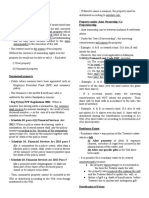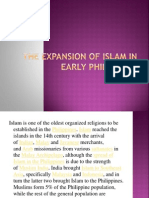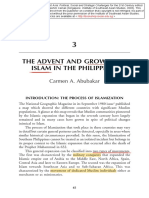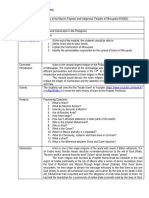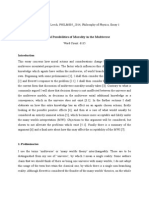Islam
Islam
Uploaded by
Jessa Marie Santos AlvarezCopyright:
Available Formats
Islam
Islam
Uploaded by
Jessa Marie Santos AlvarezCopyright
Available Formats
Share this document
Did you find this document useful?
Is this content inappropriate?
Copyright:
Available Formats
Islam
Islam
Uploaded by
Jessa Marie Santos AlvarezCopyright:
Available Formats
History of Islam in the Philippines
Source: http://www.maranao.com/bangsamoro/0104-arrival_of_islam.htm Arrival of Islam How Islam came to Mindanao and Sulu is a complex question that cannot be addressed by a single and simple answer. However, it is a fact of history that after the death of Prophet Muhammad (Peace be upon him) in 623 AC6 , a general expansion of Islam ensued. Either through missionary efforts or from military victories, the Islamic world expanded to dominate the Middle East, North Africa, Spain, Central Asia, and Eastern Europe. The spread continued towards the Sub-Saharan Africa and Southeast Asia and then to Mindanao and Sulu. That Islam came to the Philippine islands with trade route in a roundabout way is generally accepted by historians. It followed the route that originated from Arabia overland through Central Asia and then overseas to India, China and thence to Southeast Asia and Africa. However, as to which single group - traders, missionaries, crusaders, etc. - was responsible for introducing Islam in Mindanao and Sulu, the issue is still debatable. Presumably, no single operational factor is to be attributed the distinction of having spread the religion to this faraway place from the cradle of Islam. Nonetheless, after considering all the various aspects of the issue, historians seem to have agreed that the coming of Islam to Mindanao and Sulu was the result of the missionary activities of Arab traders and teachers or sufis who came along the trade routes. The participation of some Muslims from the Indo-Pakistan sub-continent is also admitted. Be that as it may, there is yet no sufficient evidence to support the contention that Islam was introduced in Mindanao and Sulu much earlier than the closing years of the fourteenth century. But there is one piece of archaeological information that may support the theory that Islam may have arrived much earlier and that was the discovery of a tombstone on the slope of Bud Datu bearing, among other entries, the year of the death of the deceased: 710 AH7, which corresponds to 1310 AC in the Gregorian calendar. The deceased was someone bearing the name of Tuhan Muqbalu or Maqbalu. The title Tuhan, said the noted Muslim scholar Cesar Adib Majul of the University of the Philippines, implied that the dead was a chief or person of high authority.' As in the Malayan peninsula, Indonesia and Borneo, the first to become Muslims in Mindanao and Sulu were those living in or near trading posts or along the trade routes. This is why most historians, if not all, believe that the early missionaries of Islam were traders. The more likely possibility, however, is that the introduction of Islam in this part of the globe, as pointed out earlier, may have resulted from the combined efforts of traders, teachers or sufis, although the appearance of a conscious and systematic plan of carrying out that task was evidently lacking. In Sulu, an Arab known locally as Tuan Mashaika was credited with having founded the first Muslim community. He married a local maiden and raised his children as Muslims. Later, in 1380, another Arab, Karimul Makhdum, reverently called Sharif Awliya, arrived and converted a large number of inhabitants to Islam. Makhdum was responsible for the founding of the first mosque in the Philippines at Tubig-Indangan on Simunul Island. In 1390, Rajah Baguinda arrived and continued the works of Makhdum. By this time, a flourishing Muslim community in Sulu evolved and by the middle of the following century the Sulu sultanate was established. The first crowned sultan was Syed Abubakar, an Arab from South Arabia, who was said to be a direct descendant of Prophet Muhammad (Peace be upon him). Upon his ascension to the throne, Abubakar used the regnal name Sharif Hashim. In Mindanao, Sharif Muhammad Kabungsuan, also claiming to be of Hashimite descent, is credited as being mostly instrumental in the propagation of the new faith in the island. He landed first at Malabang (now in Lanao del Sur) in the year 1515 and subsequently proceeded to Cotabato, where he firmly
planted the seed of the new creed. Out of his marital union with the local maidens, the Maguindanao sultanate and Buayan sultanate came into existence. Later on, succeeding sultanates, though of lesser status and power, claimed lineage from him. But before the coming of Sharif Kabungsuan, local genealogies or tarsilas of Maguindanao speak of a certain Sharif Awliya, also from Johore, who is said to have introduced Islam to the people of Mindanao around 1460. Some writers identify him as the same Karimul Makhdum who set foot in Jolo earlier. His story, though appearing mythical, is quite consequential when related to the question of who first came to plant the seed of Islam in Mindanao. He was averred to have come to Mindanao in the air in search of "Paradise" on the hill of Tantawan (now PC Hill or Colina Hill in Cotabato City). There on the hill he met an houri (celestial maiden), married her and they begot a daughter by the name of Paramisuli, a name reserved to the royalty. Sharif Awliya, not long after, quitted the place, leaving behind his wife and daughter. The Maguindanao genealogies continue to narrate that, soon after, another Arab, Sharif Maraja, also from Johore, arrived. He landed and stayed at a settlement called Slangan or what is now in the vicinity of the Post Office in Cotabato City and, soon afterward, married Paramisuli, the daughter of Sharif Awliya. Another tradition, this time from Lanao, speaks of another Sharif Alawi who came possibly by way of Maguindanao to Lanao and up to the mouth of Tagoloan River in the present-day Misamis Oriental and proceeded afterwards to Bukidnon. There is scanty evidence to prove this journey especially his missionary activities in Bukidnon, where there are pockets of Muslim communities found today. Before the advent of Islam, the people of Mindanao and Sulu were animists. There was no community ever reported orally or in writing to be monotheist. They worshipped stones, stars, moons and other inanimate objects. Diwata and anito were essential features of their belief system. Conversion to Islam was generally regarded as easy and unconstrained except in some isolated cases where clashes preceded it. With a vastly superior knowledge, usually associated with "magical powers," the newcomers easily got past the local opposition. Rendering the task much easier was the Arabian blood. running in their veins which hastened rather than hindered acceptance not only by the masses of the people but even by the old ruling classes. And with Islam came the new world outlook, power structure and the cleansing force in weeding out pagan rituals and ceremonies. It gave way to the uncompromising belief in one single Supreme Being called Allah, on the equality and brotherhood of the faithfuls, on the establishment of goodwill and prosperity to all. and revolutionized the lifestyles of the faithfuls in all spheres of existence. As proof of its persuasiveness, Islam gained new adherents who proved to be among its ablest and bravest defenders as shown in the succeeding three centuries of continuous warfare with the colonizers.
You might also like
- Villers Bretonneux WWI RF22Document10 pagesVillers Bretonneux WWI RF22Craig SawyersNo ratings yet
- Topic 4: Estate and BeneficiariesDocument9 pagesTopic 4: Estate and BeneficiariesLEANDRA ABIGAIL DE COSTANo ratings yet
- Mary Woman of Faith I by Johan RotenDocument2 pagesMary Woman of Faith I by Johan RotensherylNo ratings yet
- Early Contacts With The Neighboring CountriesDocument3 pagesEarly Contacts With The Neighboring CountriesMichelle Arce VinaraoNo ratings yet
- MANTENIMIENTO ELECTRICO ROBOTS CONTROLADOR RJ3iB ESP PDFDocument170 pagesMANTENIMIENTO ELECTRICO ROBOTS CONTROLADOR RJ3iB ESP PDFViri Hernandez MarquezNo ratings yet
- Evangelical PovertyDocument6 pagesEvangelical Povertyherbert23No ratings yet
- Four MantrasDocument3 pagesFour MantrasplanxtyscribdNo ratings yet
- Social PhilosophyDocument4 pagesSocial PhilosophyRhegell CafirmaNo ratings yet
- Priestly Formation Joe MannathDocument15 pagesPriestly Formation Joe Mannathjoshykx100% (1)
- Concept of Money Group2 1 3Document47 pagesConcept of Money Group2 1 3Danica ZabalaNo ratings yet
- Divine Revelation EssayDocument1 pageDivine Revelation EssayMark Roland HowaNo ratings yet
- EDUC-1 HandoutDocument6 pagesEDUC-1 HandoutDalen Bayogbog100% (1)
- Theory of Scientific ManagementDocument8 pagesTheory of Scientific ManagementAmba Datt PantNo ratings yet
- Science, Technology and SocietyDocument3 pagesScience, Technology and SocietyEndai DesuNo ratings yet
- The Politics of Quietist SalafismDocument28 pagesThe Politics of Quietist SalafismAbul HasanNo ratings yet
- Quality Form Course Syllabus: FR-INS-04.Rev00Document18 pagesQuality Form Course Syllabus: FR-INS-04.Rev00Jefferson CurammengNo ratings yet
- PhilosophyDocument49 pagesPhilosophyRazi AsifNo ratings yet
- Introducing ReligionDocument21 pagesIntroducing ReligionLyka AcevedaNo ratings yet
- IslamDocument4 pagesIslamAubrey Ruivivar GumatzNo ratings yet
- How Islam Came To The PhilippinesDocument2 pagesHow Islam Came To The PhilippinesRaz MahariNo ratings yet
- The Expansion of Islam in Early PhilippinesDocument11 pagesThe Expansion of Islam in Early PhilippinesKhim GoyenaNo ratings yet
- Lecture 6Document3 pagesLecture 6Aslainie M. AlimusaNo ratings yet
- Islam and Islamization of The PhilippinesDocument4 pagesIslam and Islamization of The PhilippinesAmora MaxineNo ratings yet
- Sotto, Judy Ann E. - Final Exam in Educ 102Document7 pagesSotto, Judy Ann E. - Final Exam in Educ 102judy ann sottoNo ratings yet
- Datu PutiDocument3 pagesDatu PutiKwin NieNo ratings yet
- Advent of Islam in Southeast AsiaDocument4 pagesAdvent of Islam in Southeast AsiaPalak GuptaNo ratings yet
- Module 6 HIS003 EXPANSION OF ISLAM IN SOUTH EAST ASIA 1Document7 pagesModule 6 HIS003 EXPANSION OF ISLAM IN SOUTH EAST ASIA 1ShaneNo ratings yet
- Sultanate of SuluDocument12 pagesSultanate of SuluLinas KondratasNo ratings yet
- Religion Tradition and The Dynamics of Islamization in South SulawesiDocument30 pagesReligion Tradition and The Dynamics of Islamization in South SulawesiLaci KuthyNo ratings yet
- islam in seasiaDocument16 pagesislam in seasiaLalit KumarNo ratings yet
- Keynote Conf Hist Islm Learn Africa June2023Document11 pagesKeynote Conf Hist Islm Learn Africa June2023emaanbugNo ratings yet
- History of The Birth of Islam in IndonesiaDocument4 pagesHistory of The Birth of Islam in IndonesiaRiyan BpNo ratings yet
- Islam in West Africa Introduction SpreadDocument19 pagesIslam in West Africa Introduction SpreadMatija PudicNo ratings yet
- The Rise and Fall of Sulu SultanateDocument34 pagesThe Rise and Fall of Sulu SultanateCharlyn Jane DisoyNo ratings yet
- RPH Mindanao in Pre Colonial PeriodDocument6 pagesRPH Mindanao in Pre Colonial PeriodKristine Marie Delos ReyesNo ratings yet
- OGP Outline BRRRRRRRRRRR Lesson 3Document8 pagesOGP Outline BRRRRRRRRRRR Lesson 3Divie Anne P. BardeNo ratings yet
- QGD130007Document13 pagesQGD130007Dujes ParameswaranNo ratings yet
- Islamic 11111Document10 pagesIslamic 11111Hafsat NasirNo ratings yet
- A.Abubakar-muslim Philippines Sulus Muslim Christian Contradictions Mindanao Crisis PDFDocument17 pagesA.Abubakar-muslim Philippines Sulus Muslim Christian Contradictions Mindanao Crisis PDFRina IsabelNo ratings yet
- The Arrival of Islam in The PhilippinesDocument7 pagesThe Arrival of Islam in The PhilippinesRazie Manda100% (1)
- Muslim Cultural ProfileDocument8 pagesMuslim Cultural ProfilePatricia Bawiin †No ratings yet
- Philippine History: EARLY FILIPINO AND ASIAN RELATIONSHIP AND THE COMING OF SPANIARDSDocument9 pagesPhilippine History: EARLY FILIPINO AND ASIAN RELATIONSHIP AND THE COMING OF SPANIARDSthisisme04460% (5)
- The Arrival of Islam in The PhilippinesDocument6 pagesThe Arrival of Islam in The PhilippinesRazie MandaNo ratings yet
- Abubakar - Islam in The PhilippinesDocument19 pagesAbubakar - Islam in The PhilippinesJennica A.No ratings yet
- Islam in ChinaDocument25 pagesIslam in ChinaHajj Issa100% (2)
- Bhu 2204 Islam in Kenya Latest Handout - FullDocument52 pagesBhu 2204 Islam in Kenya Latest Handout - Fullshariffidris79No ratings yet
- Islam and Islamization in The PhilippinesDocument4 pagesIslam and Islamization in The PhilippinesqwertyNo ratings yet
- BAB I-WPS OfficeDocument9 pagesBAB I-WPS OfficeUMMI HAYATINo ratings yet
- Islamization in PhilippinesDocument26 pagesIslamization in PhilippinesRuel Cedeño50% (2)
- Iwo Oni Kurani, Ilu Aafa: Evolution, Growth and Expansion ofDocument18 pagesIwo Oni Kurani, Ilu Aafa: Evolution, Growth and Expansion oftegaprince1998No ratings yet
- Islam among religions in Nigeria(1)Document33 pagesIslam among religions in Nigeria(1)animasahunabdmaliq94No ratings yet
- In Search of The Sharifi Heritage. Understanding The Significance of The Sharifi Qubrs in The Philippines.Document2 pagesIn Search of The Sharifi Heritage. Understanding The Significance of The Sharifi Qubrs in The Philippines.Prof Yusuf MoralesNo ratings yet
- Research Paper FinalDocument19 pagesResearch Paper Finalorven ebradaNo ratings yet
- OGP OutlineDocument8 pagesOGP OutlineDivie Anne P. BardeNo ratings yet
- Reaction Paper HistoryDocument2 pagesReaction Paper HistoryServy AndreiNo ratings yet
- Before The ConquestDocument25 pagesBefore The Conquestassez natNo ratings yet
- 672-Article Text-2708-1-10-20160920Document11 pages672-Article Text-2708-1-10-20160920Fella MaghfiraNo ratings yet
- Advent of IslamDocument4 pagesAdvent of IslamKaren DellatanNo ratings yet
- EXECUTIVE SUMARY Second RoundDocument13 pagesEXECUTIVE SUMARY Second RoundWinston Quilaton0% (1)
- The Coming of Islam in The Philippines: Sultan Kudarat State UniversityDocument2 pagesThe Coming of Islam in The Philippines: Sultan Kudarat State Universitymary joy pantinopleNo ratings yet
- Phil History in MuslimDocument18 pagesPhil History in MuslimJason DimituiNo ratings yet
- Islam in The Phil.Document3 pagesIslam in The Phil.Laud, Aina Erika G.No ratings yet
- ATTACHMENT 1-TECHNICAL BID EVALUATION FOR VALVES ATTACHEMENT AG 1 Rev 1Document4 pagesATTACHMENT 1-TECHNICAL BID EVALUATION FOR VALVES ATTACHEMENT AG 1 Rev 1eko123No ratings yet
- October 16, 2012 IssueDocument8 pagesOctober 16, 2012 IssueThe Brown Daily HeraldNo ratings yet
- 312 - Burn InjuryDocument1 page312 - Burn Injuryesbercinio8528valNo ratings yet
- Quectel OpenCPU Quick Start Application Note V1.1Document34 pagesQuectel OpenCPU Quick Start Application Note V1.1jijoNo ratings yet
- Basic Cooking Techniques and ProceduresDocument70 pagesBasic Cooking Techniques and ProceduresRoy CaubatNo ratings yet
- Making Sense Manual - Singularity GroupDocument35 pagesMaking Sense Manual - Singularity GroupAiNo ratings yet
- TM 11-5855-261-23PDocument29 pagesTM 11-5855-261-23PSiviNo ratings yet
- (DR - Amit Mane) New CroDocument50 pages(DR - Amit Mane) New CroHemant SharmaNo ratings yet
- Preventing Violent Behavior and Understanding Aggression in ChildrenDocument5 pagesPreventing Violent Behavior and Understanding Aggression in Childrenninja 2 niguhit remNo ratings yet
- 1107-Texto Del Artículo-4791-1-10-20200124Document21 pages1107-Texto Del Artículo-4791-1-10-20200124Luis RoblesNo ratings yet
- Provlas OromoDocument26 pagesProvlas OromoSolomon NegashNo ratings yet
- Road Safety Audit and Actions On Black Spots R&B Wing On 9th Aug 2017Document21 pagesRoad Safety Audit and Actions On Black Spots R&B Wing On 9th Aug 2017Akshay Kumar SahooNo ratings yet
- Comparing Plant and Animal Cells LabDocument5 pagesComparing Plant and Animal Cells LabkerwynnNo ratings yet
- BusinessWorld 6 27 2012Document23 pagesBusinessWorld 6 27 2012Cedric John AmolozaNo ratings yet
- Plan Aws Solutions ArchitechtDocument5 pagesPlan Aws Solutions Architechtaimenlechekhab15No ratings yet
- 7714 15346 1 PBDocument6 pages7714 15346 1 PBВлад ДігтярNo ratings yet
- Receiving IDOCs From SAP by Using BizTalk ServerDocument13 pagesReceiving IDOCs From SAP by Using BizTalk ServerKishore ReddyNo ratings yet
- BCIT COMP 7005 TCP and FTP Protocol Analysis Final Project by Wesley Kenzie, December 2010Document117 pagesBCIT COMP 7005 TCP and FTP Protocol Analysis Final Project by Wesley Kenzie, December 2010Wesley Kenzie100% (2)
- CME - Comparing E-Minis and ETFs - Sep2012 PDFDocument8 pagesCME - Comparing E-Minis and ETFs - Sep2012 PDFbearsqNo ratings yet
- The Real Possibilities of Morality in The MultiverseDocument18 pagesThe Real Possibilities of Morality in The MultiverseDan Leech100% (1)
- Lesson 2 Introduction To Principles of Web DesignDocument5 pagesLesson 2 Introduction To Principles of Web DesignDavid KimathiNo ratings yet
- Leadership Feedback Assessment Survey ReportDocument6 pagesLeadership Feedback Assessment Survey ReportRaydene Grace FloresNo ratings yet
- Test Unit 1 and Unit 2Document4 pagesTest Unit 1 and Unit 2bebeulemNo ratings yet
- Questionnaire Vol.2 Questionaire Survey On Collection and Waste Segregation ProblemDocument4 pagesQuestionnaire Vol.2 Questionaire Survey On Collection and Waste Segregation ProblemGynolderNo ratings yet
- Describing My KitchenDocument3 pagesDescribing My KitchenRicardoSerratoNo ratings yet
- Marine Life Text - EC 6th GRADEDocument2 pagesMarine Life Text - EC 6th GRADEwhiteswandiariesNo ratings yet
- Vibhuti PadaDocument50 pagesVibhuti PadaAnkit LatiyanNo ratings yet

